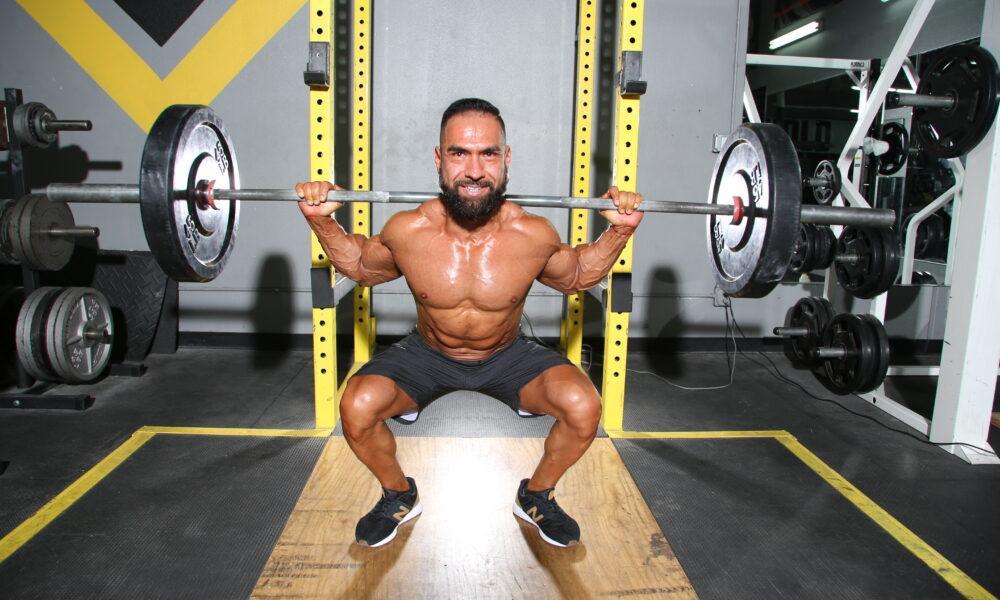

In bodybuilding, legs are the sturdy foundation upon which our physique stands. However, due to factors like genetics and lifestyle, some bodybuilders may have weak and thinner legs that cannot support their fitness performance and enhance aesthetics, hence the need to grow them bigger.
Bigger legs enhance your physique and improve stability, posture, and athletic performance. They also provide a solid base for strength and power in various exercises.
But how do you grow your legs bigger?
This article explores various proven strategies and tips to help you grow your leg bigger and stronger, from targeted exercises that engage every muscle group in your legs to key principles of progressive overload and recovery.
Why Training Legs is Important
Working out the legs is crucial for overall fitness and contributes to several health benefits. Here are five reasons why incorporating leg workouts into your fitness routine is important:
1. Build Muscles
Training your legs with compound exercises such as squats and deadlifts recruits a large muscle group, which helps produce elevated testosterone and cortisol hormones. Testosterone hormones help in increasing muscle mass growth and strength.
Besides the production of hormones, legs contain some large muscle groups like the quadriceps, hamstrings, and glutes. The engagement of these muscles in leg exercises alone promotes muscle development and increases overall strength.
2. Burns More Calories
Working out your leg muscles, such as the hamstring, calves, quads, and glutes, requires significant energy.
Training legs elevates your heart rate and metabolism, burning more calories to generate the energy required during and even after the workout. As a result, you promote weight and fat loss and lean mass development.
A study tracked certain athletes’ metabolism and energy expenditure after heavy resistance training to prove this fact. The findings showed that after 90 minutes of working out with compound exercises like squats and deadlifts, the participants’ metabolic rates and energy increased and kept increasing for several hours afterward.
3. Builds a Balanced Physique
Performing unilateral leg workouts builds strong and well-defined legs, which creates a sense of proportion to the upper body. This contributes to an aesthetically pleasing physique and avoids an imbalanced appearance where the upper body is significantly larger than the lower body.
4. Improves athletic Performance
Many sports and athletic activities require a powerful lower body to produce more strength when weight lifting.
Training your legs improves lower body strength, which helps improve performance in activities like running, jumping, and workouts that involve lateral movements like bench pressing.
5. Prevents injury and supports Joint Health
Muscle imbalances, poor coordination, and inflexibility can increase the chances of getting lower back pain and injuries in the gym.
Working out your legs with squats and deadlifts can strengthen and develop the muscles around the weak knee joints, providing stability to these joints, preventing injuries, and ensuring the longevity of your fitness journey.
Leg exercise also rectifies muscle imbalances caused by poor training strategies and unilateral training that predominantly uses one leg, which might contribute to injury prevention.
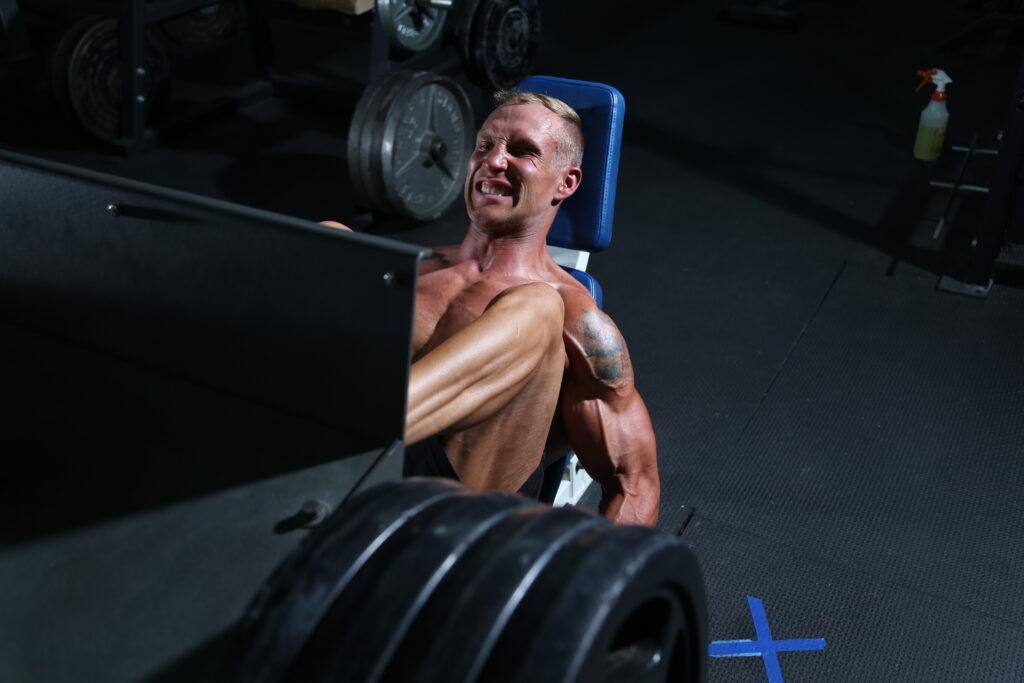
5 Tips for Growing Bigger Legs
Now that you understand why you should train your legs, let’s learn six tips to help you build stronger bigger legs. These tips include the following.
1. Warm Up First
Like any other body part, leg training requires some warm-up to prepare it for major workouts and prevent the risk of injury during and after the workout.
Warming up dilates your blood vessels, allowing more blood to flow through your muscles to the legs. This increased blood flow delivers oxygen and nutrients to the working muscles, providing strength for training to grow bigger legs.
Before proceeding to compound exercises like calf raises, warm up by doing dynamic stretches or cardio exercises like walking on a treadmill at a steady pace, jumping, and cycling.
Besides supplying nutrients to your legs, warm-up exercises will warm your muscles and make them more elastic. Warm and elastic muscles prevent injuries related to exercising with cold muscles and make them less likely to suffer damage.
2. Focus on Compound Workouts
Compound functional exercises are the best way to build and develop stronger and bigger legs. They recruit more muscle fibers and activate multiple muscle groups at once with a greater load than isolation exercises.
The increased recruitment and activation of leg muscles leads to more significant muscle growth and development. For instance, movements like squats and lunges simultaneously engage the quadriceps, hamstrings, glutes, and calf muscles to grow bigger muscles.
Along with compound exercises, consider adding various movement patterns throughout different directions of motion. For instance, for extension movement, add lunge or squat; for flexion movement, add hamstring curls; for hip hinges, incorporate deadlifts and plantarflexion; do calf raises and box jumps.
These exercises will help establish a foundation for your session and provide diversity in the targeted leg muscles to enhance performance, strength, and flexibility.
3. Emphasize Progressive Overloads
When planning to start leg exercise, focus on progressive overload–the gradual increase of the weight and the intensity of your workout over time.
By consistently challenging leg muscles with heavier weights or increased resistance, you induce microscopic damage to muscle fibers. The body responds by repairing the damaged tissue by building new muscle tissue and recruiting more muscle fibers, resulting in larger and more developed legs.
4. Train Legs Unilaterally
It is common to train one leg more than the other because we all have one dominant side.
While it may seem good, it may cause muscle imbalances and bad posture, leading to injuries when training.
To avoid such, ensure you train your legs unilaterally by incorporating unilateral exercises such as single-leg deadlifts, dumbbell lunges and single-leg squats to ensure both legs develop muscle evenly.
5. Do Isolation Exercises
Isolation exercises such as leg extension and curl machines help to perfect the definition of leg muscles such as hamstring and quadriceps.
After compound exercises, do isolation exercises at a light to moderate resistance and in higher repetition.
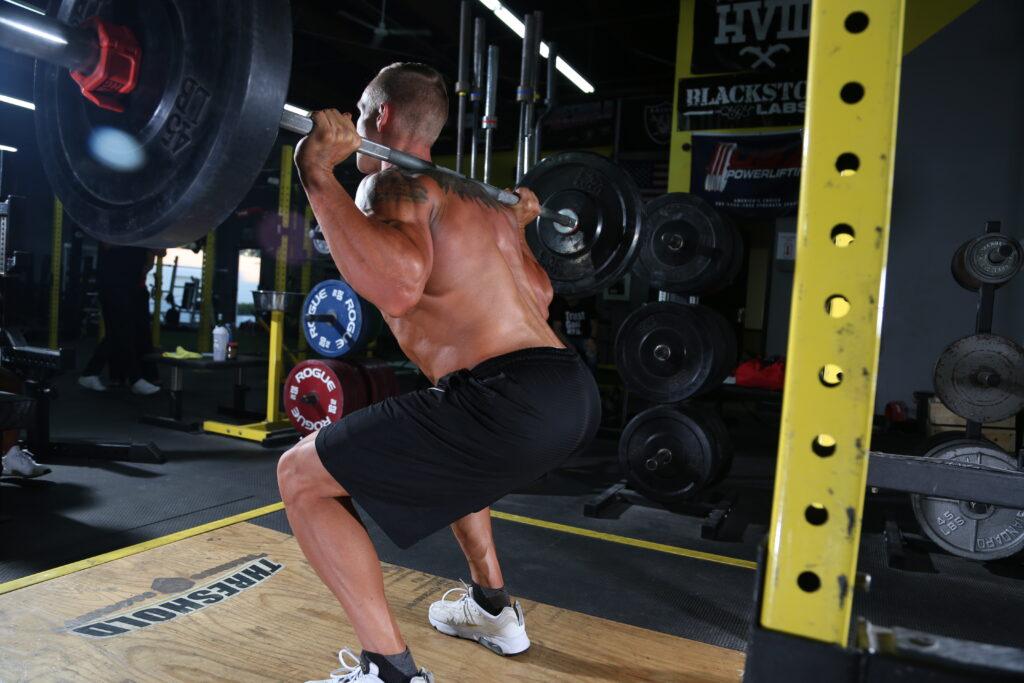
Top 5 Leg Exercises for Stronger and Bigger Legs
Below are the five best exercises for your legs. When performed correctly, they will help your legs grow stronger and bigger. They include:
1. Romanian Dumbbell Deadlift
A Romanian dumbbell deadlift is an excellent workout for building your glutes, lower back, and primarily the hamstring.
How to Do Romanian Dumbbell Deadlift
- Start with your feet shoulder-width apart, holding a dumbbell in each hand. Your palm should be facing your thighs and your core engaged.
- Slightly bend your knees and hinge at your hips to slowly lower the dumbbells around the middle of your shins. Your back should stay stared.
- Slowly raise to the starting point while focusing on your glutes and hamstring muscles.
- Perform 3 sets of 8- 12 repetitions.
This exercise is for intermediate and advanced bodybuilders. If you are a beginner, consider starting with body weight or light weights to prevent injury and back pain.
2. Barbell Squat
Barbell squat is a compound exercise that targets the quad, glutes, hamstring, calves, abdominals, and lower back. If you are new to it, start without workout equipment and gradually introduce the weight with time.
How to Do Barbell Squats
- Place the barbell on the squat rack at about chest height and move two steps back
- Approach the bar and duck underneath it.
- Lift the barbell off the rack and position it across your upper back, just below the base of your neck. Grip the bar with both hands slightly wider than shoulder-width apart. Ensure your wrists are straight.
- Take a step or two back, ensuring your feet are stable and you have enough space to perform the squat.
5. Set your feet shoulder-width apart or slightly wider. Your toes can point slightly outward.
- Lower your body by slowly pushing your hips back and bending your knees. Keep your knees tracking over your toes, and aim to descend until your thighs are parallel to the ground or lower.
- Push through your heels and drive your hips forward to return to the starting position.
- Do 2 to 3 sets of 8-12 reps.
3. Leg Press
Leg press primarily targets the quads, glutes, and hamstrings. It challenges your leg muscles to grow bigger by allowing you to add volume (weight)to your legs without loading the spine since it involves a leg press machine.
How to Perform Leg Press
- Sit on the leg press machine with your back and head resting against the seat.
- Put your feet shoulder-width apart on the footplate. Your feet should bend at an angle of 90 degrees, and your toes should point straight ahead or slightly outward, depending on your comfort.
- Grasp the handles on the sides of the seat for stability and slowly push the footplate away from you by extending your knees until your feet are straight. Your core should be engaged.
- Hold for 3 seconds before bending your knees to return to the starting point.
- Extend your knees without locking them and ensure they remain on the footplate the entire exercise. Repeat the leg press 8-12 repetitions of 2-3 sets.
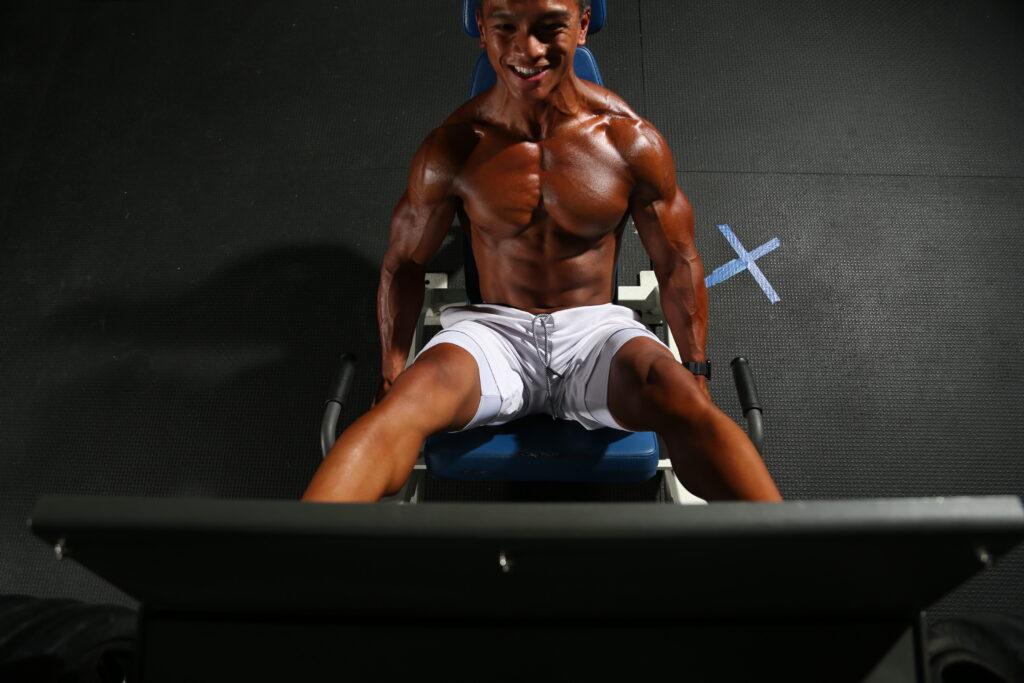
4. Lunge
Lunges are great lower-body exercises for beginners and advanced bodybuilders. You can add weights as you progress, such as holding a pair of dumbbells in each hand.
Lunges work on the quadriceps, hamstrings, glutes, and calves. They also engage the core for stability.
How to Perform Lunges
- Stand with your feet hip-width apart and your shoulders back and chest up.
- Step forward with your right foot and bend your knee at a 90-degree angle. Your back knee should also be bent at 90 degrees and close to, but not touch the ground.
- Keep your front knee above your ankle, and make sure it doesn’t extend past your toes.
- Push off with your front foot to return to the starting position.
- Switch sides and repeat the lunge on the other leg by stepping forward with your left foot.
5. Bulgarian Split Squat
The Bulgarian split squat is a variation of the traditional lunge that emphasizes the muscles of one leg at a time. This exercise targets the quadriceps, hamstrings, glutes, and stabilizing muscles.
How to perform the Bulgarian split squat
- Place a bench in front of you and stand about two feet away with your back facing it.
- Place your right foot behind you on the bench, with the top of your foot resting on the surface. The toes of your back foot should be pointing down.
- Position your left leg far enough in front and bend to your knee to lower your body as low as possible. Your front knee should be directly above your ankle, and your chest, hip, and shoulder should be facing outwards.
- Push through your front foot to return to the starting position, straightening your front leg.
- Switch legs and perform the same movement on the other leg by switching the position of your feet.
Several workouts can help you develop bigger legs that you can’t lean in a single session. Apart from the workout mentioned above, other leg exercises to build bigger legs include:
- Leg extensions
- Standing calf raises
- Hip thrusts
- Deadlifts
- Seated leg curls
- Unilateral supersets
- Kettle swings
Like any other body part, train your legs two to three days a week to give your muscles ample time to recover from damage caused during training and allow muscles to adapt and grow.
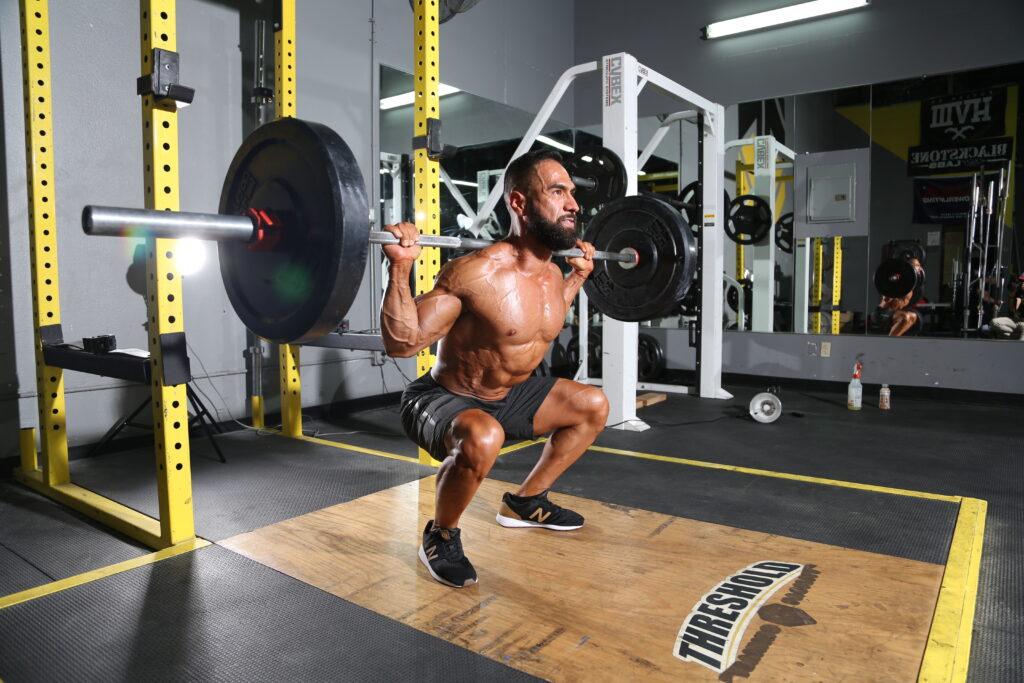
Conclusion
Building stronger and bigger legs requires a strategic and well-rounded approach encompassing various aspects of fitness, including training, nutrition, and recovery.
Prioritize compound exercises like squats, lunges, and deadlifts, which engage multiple muscle groups simultaneously. These movements stimulate greater muscle activation and contribute to overall leg strength and size.
Also, apply the principle of progressive overload by gradually increasing the resistance, intensity, or volume of your workouts.
Additionally, include isolation exercises and training your legs at least 2 to 3 times weekly.





















You must be logged in to post a comment Login